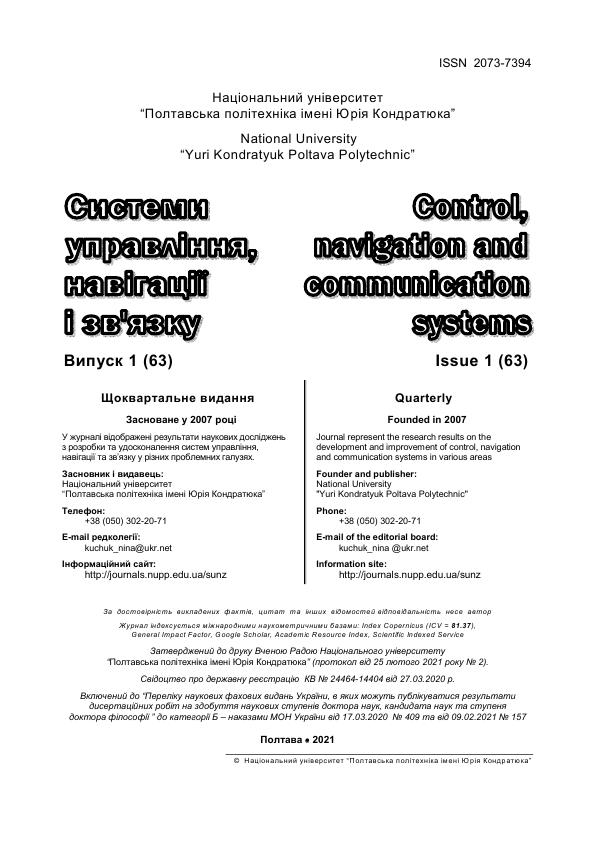MODERN INTELLECTUAL METHODS OF MODELING COMPLEX TECHNOLOGICAL OBJECTS
DOI:
https://doi.org/10.26906/SUNZ.2021.1.049Keywords:
deterministic models, stochastic models, structural identification, parametric identification, passive experiment, active experimentAbstract
One of the key issues in the synthesis of automatic control systems is the development of adequate mathematical models of control objects. Development of models of physical systems is a very complex and time-consuming work, which takes from 80 to 90% of the effort required for the analysis and synthesis of control systems and includes the following stages: determining the process parameters that affect the object of control; determination of connections between parameters; drawing up material and energy balances of control objects; linearization of these balances; obtaining a differential equation. The result of modeling of almost all technological objects is a complex differential equation of large order, which is then used to calculate automatic control systems. A mathematical model is usually understood as a set of relations (equations, logical conditions, operators, etc.) that determine the characteristics of the states of the modeling object. Modern science and technology as objects of study consider the material objects of the surrounding world and their physico-chemical transformations. The practical implementation of these studies from laboratory installations to industrial production uses modeling as a process of cognition, as well as for optimal organization, operation, and management of production. Modern technologies are characterized by high complexity, which is manifested in the large number and variety of parameters that determine the course of processes, internal relationships between parameters, their mutual influence, and the change of one parameter can cause nonlinear change of other parameters. This complexity is exacerbated by the occurrence of multiple feedbacks between parameters, as well as uncontrolled perturbations randomly distributed over time. The information potential generated by technological processes is extremely large. With limited perceptions, it is necessary to reduce this potential, which will ultimately lead to a reduction in alternatives when making management decisions. This is achieved by knowing the process through models - simplified systems that reflect individual, limited in the right direction, aspects of the process under consideration. There are many ways to obtain models of technological processes. Each method makes it possible to build a model that is adequate to the process in a sense, depending on the chosen criterion. This means that there is some abstract correspondence between the set of models and the modeled object. The simulation, in fact, is based on the use of a dynamic analogy, which means a non-identical similarity of properties or relationsDownloads
References
Математичне моделювання технологічних об’єктів: Підручник. / О.Б. Целіщев, П.Й. Єлісєєв, М.Г. Лорія, І.І. Захаров.– Луганськ: Вид-во Східноукр. нац. ун-ту. – 2011. – 421 с.
Черноруцкий И.Г. Методы оптимизации в теории управления: учебное пособие / И.Г. Черноруцкий. — СПб.: Питер, 2004. — 256 с.
Стенцель Й.І. Математичне моделювання технологічних об’єктів керування. – К.: IСДО, 1993. – 328 с.
Johnson M.A. PID Control. New Identifications and Design Methods / M.A. Johnson, M.H. Moradi. – London: Springer, 2005. – 544 p.
Дьяконов В.П. Mathcad 11,12,13 в математике / В. П. Дьяконов. – М.: Горячая линия – Телеком, 2007. – 958 с.
Дорф P. Современные системы управления/ Р. Дорф, Р. Бишоп. — М.: Лаборатория Базовых Знаний, 2002. — 832 с.
Іванов А.О. Теорія автоматичного керування: Підручник / А.О. Іванов. – Дніпропетровськ: Національний гірничий університет. – 2003. – 250 с.
Теорія автоматичного керування / Л.М. Артюшин, О.А. Машков, Б.В. Дурняк, М.С. Сівов. – Львів: У АД, 2004.– 272 с.
Алексеев А.А. Идентификация и диагностика систем: учеб. для студ. высш. учеб. заведений / А.А. Алексеев, Ю.А. Кораблев, М.Ю. Шестопалов. — М.: Издательский центр «Академия», 2009. – 352 с.
Стенцель Й.І. Ідентифікація та математичне моделювання / Й.І. Стенцель – Луганськ: Вид-во Східноукр. нац. ун-ту. – 1995. – 247 с.




